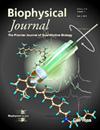Crumbs2 acts as a dynamic cellular sensor triggering stable podocyte cell-matrix anchorage.
IF 3.2
3区 生物学
Q2 BIOPHYSICS
引用次数: 0
Abstract
Mammalian crumbs proteins (CRB) 2 and 3 are expressed in the kidney, with CRB2 mainly found within podocytes. Here, we focused on the function of CRB2 in podocytes. We investigated the CRB2/CRB3A membrane dynamics at the podocyte-podocyte contact interface in a cell culture model. Traction force microscopy was employed to clarify whether the homophilic CRB2 interactions occur in cis or trans. Live-cell imaging revealed the effects of CRB2 and CRB3A expression on cell migration from the single cell level to large cellular networks at long space and time scales. We found that CRB2 interacts in trans, but surprisingly does not form stable interconnections. Instead, CRB2 acts as a dynamic sensor for the cellular environment and triggers a massive reorganisation of focal adhesions and the actin cytoskeleton upon contact of CRB2-positive cells resulting in a strongly increased cell-matrix anchoring. Cytoskeleton reorganization can also be triggered by CRB3A, however, the increased cell-matrix anchorage is CRB2-specific.crums2作为一个动态的细胞传感器,触发稳定的足细胞-基质锚定。
哺乳动物碎屑蛋白(CRB) 2和3在肾脏中表达,CRB2主要存在于足细胞中。在这里,我们主要研究CRB2在足细胞中的功能。我们在细胞培养模型中研究了足细胞-足细胞接触界面上CRB2/CRB3A膜的动力学。采用牵引力显微镜来澄清亲同性CRB2相互作用是发生在顺式还是反式中。活细胞成像揭示了CRB2和CRB3A表达在长时间和空间尺度上对细胞从单细胞水平向大细胞网络迁移的影响。我们发现CRB2在反式中相互作用,但令人惊讶的是没有形成稳定的相互连接。相反,CRB2作为细胞环境的动态传感器,在CRB2阳性细胞接触时触发局灶粘连和肌动蛋白细胞骨架的大规模重组,导致细胞基质锚定的强烈增加。细胞骨架重组也可以由CRB3A触发,然而,增加的细胞基质锚定是crb2特异性的。
本文章由计算机程序翻译,如有差异,请以英文原文为准。
求助全文
约1分钟内获得全文
求助全文
来源期刊

Biophysical journal
生物-生物物理
CiteScore
6.10
自引率
5.90%
发文量
3090
审稿时长
2 months
期刊介绍:
BJ publishes original articles, letters, and perspectives on important problems in modern biophysics. The papers should be written so as to be of interest to a broad community of biophysicists. BJ welcomes experimental studies that employ quantitative physical approaches for the study of biological systems, including or spanning scales from molecule to whole organism. Experimental studies of a purely descriptive or phenomenological nature, with no theoretical or mechanistic underpinning, are not appropriate for publication in BJ. Theoretical studies should offer new insights into the understanding ofexperimental results or suggest new experimentally testable hypotheses. Articles reporting significant methodological or technological advances, which have potential to open new areas of biophysical investigation, are also suitable for publication in BJ. Papers describing improvements in accuracy or speed of existing methods or extra detail within methods described previously are not suitable for BJ.
 求助内容:
求助内容: 应助结果提醒方式:
应助结果提醒方式:


